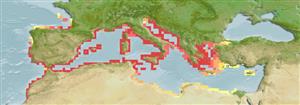>
Eupercaria/misc (Various families in series Eupercaria) >
Labridae (Wrasses)
Etymology: Labrus: Name from Latin 'labrum' for lip, rim or edge; referring to the big lips of the fishes of the genus (from Ovid and Pliny according to Petrus Artedi).
More on author: Linnaeus.
Environment: milieu / climate zone / depth range / distribution range
Ecologia
marino associati a barriera corallina. Subtropical; 48°N - 29°N, 11°W - 43°E
Eastern Atlantic: Portugal to Morocco, and the Mediterranean and Black Sea.
Length at first maturity / Size / Peso / Age
Maturity: Lm ?, range 16 - ? cm
Max length : 47.0 cm SL maschio/sesso non determinato; (Ref. 4742); common length : 37.5 cm SL maschio/sesso non determinato; (Ref. 4742)
Adults are found in littoral zone, near rocks and eel-grass beds (Ref. 3666). Oviparous, distinct pairing during breeding (Ref. 205). Males build dish shaped nests and guard the eggs (Ref. 205).
Life cycle and mating behavior
Maturità | Riproduzione | Deposizione | Uova | Fecundity | Larve
Oviparous, distinct pairing during breeding (Ref. 205). Males build dish shaped nests and guard the eggs (Ref. 205).
Bauchot, M.-L. and J.-P. Quignard, 1979. Labridae. p. 426-443. In J.C. Hureau and Th. Monod (eds.) Check-list of the fishes of the north-eastern Atlantic and of the Mediterranean (CLOFNAM). UNESCO, Paris. Vol. 1. (Ref. 3666)
IUCN Red List Status (Ref. 130435: Version 2024-1)
Threat to humans
Harmless
Human uses
Pesca: commerciale
Strumenti
Special reports
Download XML
Fonti Internet
Estimates based on models
Preferred temperature (Ref.
123201): 17.4 - 20.3, mean 18.9 °C (based on 389 cells).
Phylogenetic diversity index (Ref.
82804): PD
50 = 0.5625 [Uniqueness, from 0.5 = low to 2.0 = high].
Bayesian length-weight: a=0.01148 (0.00712 - 0.01853), b=2.98 (2.84 - 3.12), in cm total length, based on LWR estimates for this species & (Sub)family-body (Ref.
93245).
Trophic level (Ref.
69278): 3.9 ±0.4 se; based on diet studies.
Resilienza (Ref.
120179): Basso, tempo minimo di raddoppiamento della popolazione 4.5 - 14 anni (Preliminary K or Fecundity.).
Fishing Vulnerability (Ref.
59153): Moderate vulnerability (43 of 100).
Nutrients (Ref.
124155): Calcium = 25.7 [13.2, 58.8] mg/100g; Iron = 0.562 [0.305, 1.051] mg/100g; Protein = 19.5 [16.7, 21.8] %; Omega3 = 0.243 [0.139, 0.419] g/100g; Selenium = 18.8 [9.4, 36.0] μg/100g; VitaminA = 47.5 [14.5, 196.6] μg/100g; Zinc = 0.715 [0.463, 1.152] mg/100g (wet weight);
